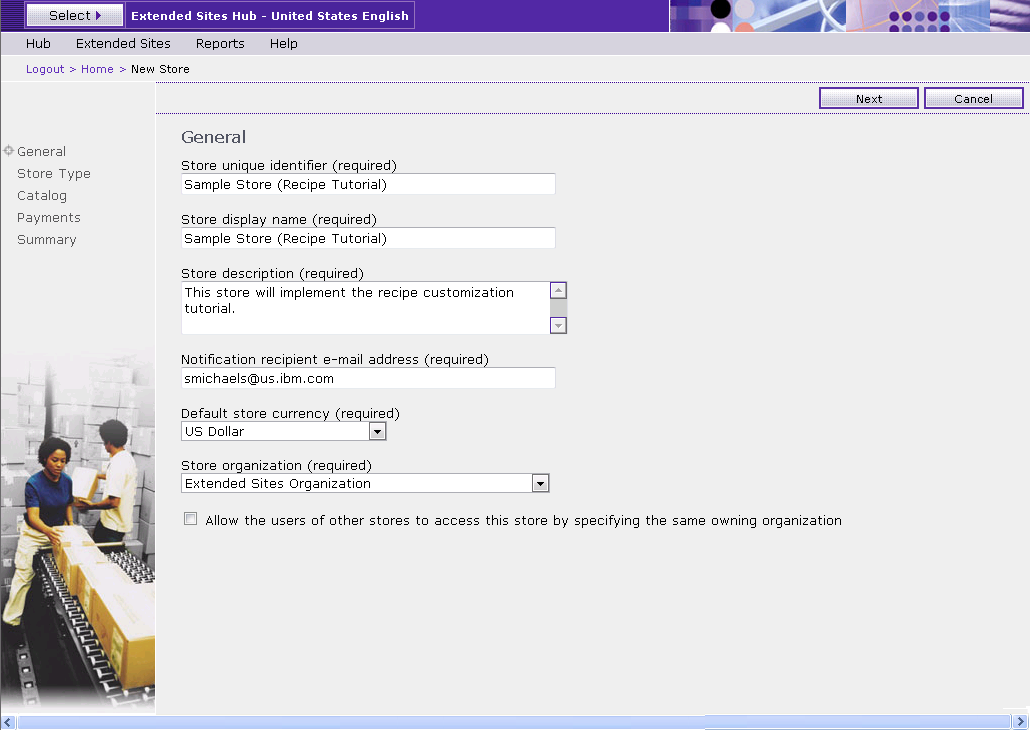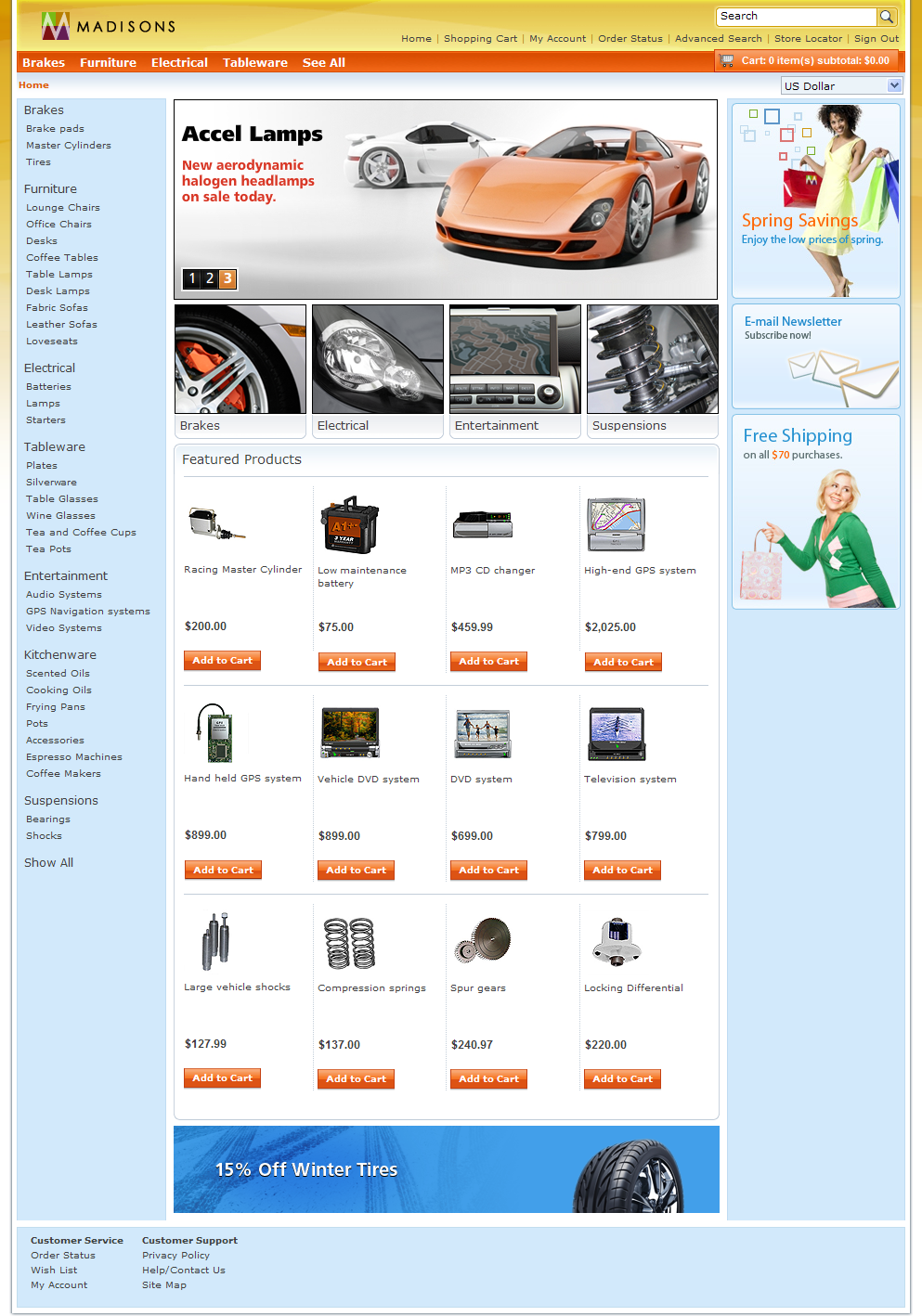Creating an extended site store for the Recipes tool customization
About this task
Procedure
- Publish a custom .sar file on the default extended sites
catalog.
The examples in the Recipes tool scenario use products in the Kitchenware category of the Madisons starter store catalog. This catalog is not available when you are creating an extended sites store. Therefore, you must publish the Housewares.sar file in the extended sites store after created the store.
- Download HousewaresCatalog.sar into a temporary directory.
- Go to WCDE_installdir\conf\sar. If the directories conf and sar do not exist, create the directories.
- Add HousewaresCatalog.sar into the WCDE_installdir\conf\sar directory.
- If the WebSphere Commerce Test Server is not running, start the server and log on to the Administration Console.
- Select Site > Store Archives > Publish.
- If ExtendedSites.sar is published,
proceed to step 1 h. If the store archive is not published, check
the box next to ExtendedSites.sar and click Next.
This step enables the Extended Sites Asset Store as a parameter in later steps.
For more information, see Viewing publish status.
- On the parameters page, select Automotive under Sample data and ATP under Inventory model. Click Next > Finish to publish the store.
- Select Site > Store Archives > Publish; check the box next to HousewaresCatalog.sar and click Next.
- On the Parameters page, select Extended Sites Catalog Asset Store; click Next > Finish. Confirm that the catalog was successfully published.
- Create the store:
- Log on to WebSphere Commerce Accelerator, select Extended Sites Hub; click Ok.
- From the Extended Sites menu, select New Store.
- On the General page, complete the
store information fields and select Extended Sites Organization under Store
organization; click Next.

The general information for a new extended sites store must be completed. For this tutorial, type Sample Store (Recipe tutorial) into the Store unique identifier field and the Store display name field. The third field is a description of the store; type in the text "This store implements the Recipe customization tutorial." The fourth field requires the email address of the person to notify when the store is created. The fifth and final field before you specify the type of Store organization, requires you to select the default currency of the store; select "US Dollar". - On the Store Type page, select MadisonsStorefrontAssetStore and click Next.
- On the Catalog page, select the store master catalog that has the description Visit the largest online retail store of apparel. Shop the wide selection in activewears, jeans, pants, shorts, and accessories for men and women. Be sure to select this catalog, as there can be two Store master catalogs. Click Next.
- On the Payments page, select any desirable options. The options do not affect the tutorial. Click Next > Finish to create the store.
- On the Store Creation Confirmation page, click Bookmark Store to save the URL for the store home page to your browser. Use this bookmark to view your store home page by selecting the bookmark in your Internet browser.
- Log out of the WebSphere Commerce Accelerator.
- Log on to the WebSphere Commerce Accelerator.
- From the Store menu select Sample store (Recipe Tutorial)
- Select Store > Open/Close > Launch. The store is now viewable and contains the default
extended sites car parts catalog, and the Madisons starter store catalog.

- Filter out unused product categories that are inherited
from the asset store by your extended site store. You need to use only the Kitchenware category of the catalog.
 Note: If your store has catalog filter and pricing is
enabled, use the Catalog Filter and Pricing tool
in the Management Center to filter unused categories. For more information, see Catalog Filter and Pricing tool.
Note: If your store has catalog filter and pricing is
enabled, use the Catalog Filter and Pricing tool
in the Management Center to filter unused categories. For more information, see Catalog Filter and Pricing tool.- In WebSphere Commerce Accelerator, select Sample store (Recipe Tutorial) from the Store menu.
- Select Merchandise > Catalog Filter.
- Right-click the Kitchenware category; click Include,
then Save.A green check mark appears on the Kitchenware folder, then the category is published.

- Optional: If there are green check marks on categories other than Kitchenware, right-click the categories and click Exclude, then Save.
The store is now created and is ready to be customized to implement a recipes section. The home page can look like the following screen capture:
To change the default extended sites automotive E-Marketing spots to the Madisons housewares E-Marketing spots, you must customize the store JSP files and image files. For more information about E-Marketing spots, see Working with e-Marketing Spots.
- Optional: If you do not remember the storeent_id
of the created store, find the storeent_id by following these instructions.
The storeent_id is needed when you are inserting recipe test data in other lessons. Therefore, you require the storeent_id of this store to associate recipes with it.
- Access the WebSphere Commerce database through the following link: http://localhost/webapp/wcs/admin/servlet/db.jsp
- Submit the SQL query:
select * from storeent; - Find the row that represents the created store. The store name is in the identifier column. The created store's storeent_id is the number in the storeent_id column of that row.